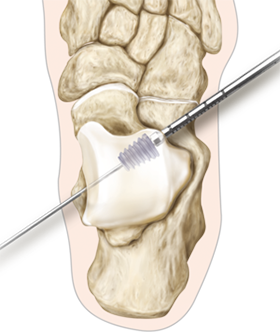 In its most pure definition, Arthroereisis describes the limitation of a joint motion. A Subtalar Joint Arthroereisis with a sinus tarsi implant is a surgical technique to treat flatfeet in both the pediatric and adult population.
In its most pure definition, Arthroereisis describes the limitation of a joint motion. A Subtalar Joint Arthroereisis with a sinus tarsi implant is a surgical technique to treat flatfeet in both the pediatric and adult population.
It has been demonstrated that subtalar arthroereisis returns substantially deforming forces and moments of the flatfoot back toward the values experienced in a normal foot. Subtalar arthroereisis is intended to assist in treating the hyperpronated foot by stabilizing the subtalar joint. It is intended to block forward, downward, and medial displacement of the talus, thereby limiting excessive eversion of the hindfoot. The subtalar implant is also designed to be used as an adjunct in conjunction with other corrective procedures, including posterior tibial tendon reconstruction, FDL tendon transfers, and the medial displacement calcaneal osteotomy.
When is Subtalar Arthroereisis Recommended?
From a pediatric viewpoint, surgical treatment of children’s flexible flatfoot is unusual and only indicated in patients whose feet do not correct spontaneously and are symptomatic. Symptoms normally include pain, fatigue, difficulty playing sports or walking on uneven surfaces, and cramps. Surgery is indicated if the child also demonstrates most of the following criteria: severe flatfoot without clinical and radiologic improvement after at least 2 years of conservative treatment, hindfoot valgus greater than 10º, shortness of the Achilles tendon, Viladot footprint type II, III, or IV, pathologic x-ray measurements.
In adults, subtalar arthroereisis is an alternative to medial displacement calcaneal osteotomy (MDCO) in the treatment of stage IIA posterior tibial tendon (PTT) dysfunction, where valgus hindfoot is the main deformity. The sinus tarsi implant maintains the normal foot architecture and acts as a splint allowing the healing of the tibialis posterior tendon reconstruction.
Compared with Medial Displacement Calcaneal Osteotomy (MDCO), the subtalar arthroereisis surgery has some advantages. It is a less invasive procedure making it easier and quicker to perform. There is no risk of nonunion or malunion; there is no risk of damaging medial neurovascular structures and the sural nerve; and it requires less immobilization time and less non-weightbearing time after surgery, thus yielding to a shorter recovery time.
If you have any additional questions or concerns, contact our South Florida foot doctor at 954-906-9272 and make an appointment today.
Subtalar Arthroereisis Procedure
A small incision is made on the lateral side of the hindfoot over the sinus tarsi. A blunt lever is introduced through the sinus tarsi and under the neck of the talus. The lever is pushed distally so that the hindfoot is supinated, and at the same time, the assistant pronates the forefoot. This procedure aims to move the head of the talus upward, backward, and outward, so that it is repositioned in its physiologic position and hindfoot pronation is corrected.
To maintain the correction obtained, an endorthesis is inserted in the sinus tarsi. First, the trial implants are inserted until the appropriate implant size is determined. The surgeon will use the smallest implant that corrects the deformity and remains stable in the sinus tarsi while moving the subtalar joint. At this point (with the trial implant inserted), Percutaneous Achilles tendon reconstruction is completed with the correct tendon tension. Finally, the definitive endorthesis is implanted, the same size as the trial implant. Closure of the wound is performed in a routine fashion and a below-the-knee compression cast is applied.
If you feel you would benefit from a Subtalar Arthroereisis procedure don’t hesitate to contact our office today for a consultation with a lead podiatrist in South Florida. Schedule an appointment online today.
References:
1. American Orthopaedic Foot & Ankle Society – https://www.aofas.org/PRC/meeting/Documents/iffassymposium6sunday1100alvarez.pdf
